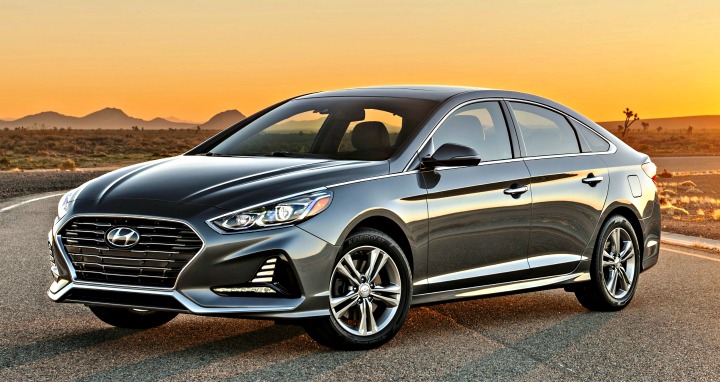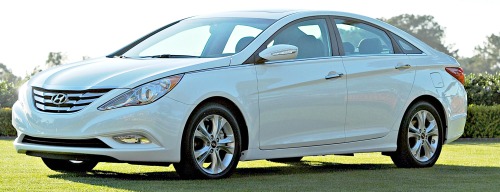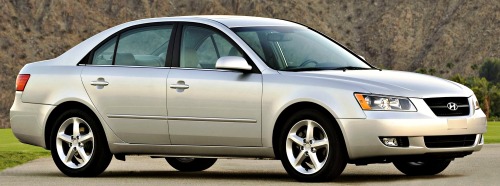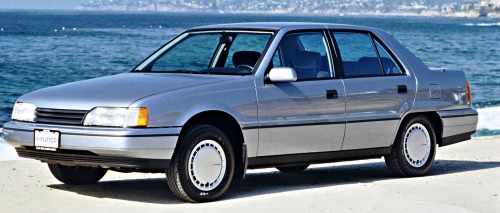How Sonata Turned Hyundai’s Reputation Around

By Tim Spell
The story of Hyundai is a classic one. Consumers doubting its quality placed a chip on the shoulders of the automaker, which prodded the company to aggressively push forward, create innovative solutions and produce strong-value-proposition cars like its Sonata sedan to achieve outstanding success.
During the past few decades, a handful of Asian-brand vehicles have greatly impacted the U.S. midsize-sedan market. Hyundai’s Sonata joins these icons, teaming with the likes of Toyota Camry, Honda Accord and Nissan Altima in making huge contributions to the image and sales success of the vehicles’ respective brands.
While it hasn’t generated the lofty sales numbers of Camry or Accord, Sonata has evolved from humble beginnings to become a strong seller and standout player in the South Korean automaker’s remarkable history. It’s a major contributor to the transformation of Hyundai’s brand perception from having inferior quality to being solid, well-rounded products.
Sonata’s ranking of fourth among midsize cars in J.D. Power and Associates 2017 Initial Quality Study is among the fruit of a journey highlighted by breakthroughs in marketing, engineering and design.
Hyundai arrives on the market with the Excel
Hyundai entered the U.S. market in 1986, rolling out its subcompact Excel model to compete in the entry-level segment. First-years sales were encouraging, and Hyundai expanded its operation from coast to coast in 1987.
A key part of the manufacturer’s U.S.-growth strategy was to introduce the midsize Sonata sedan into the lineup in 1988 as a 1989 model. It was the second generation of the vehicle, introduced in 1985, mainly for the South Korean market.
The 1989 Sonata had the disadvantage of being a bit smaller than the competition, says John Shon, senior manager, product planning, Hyundai Motor America. It was a “tweener” vehicle, Shon says, with dimensions falling somewhere between a midsize and compact car. Sonata wasn’t well-received by consumers, and sales were meager.
A third-generation Sonata was produced between 1993 and 1998, which had more global appeal and improved sales. It was sold in the United States during the thick of an era of negative Hyundai brand image, mainly caused by the problem-riddled Excel, which was built through the 2000 model year. The subcompact’s reliability issues cast a pall of consumer skepticism regarding quality over the entire lineup.
Hyundai became the butt of jokes, and talk-show host David Letterman was the most-noted brand disparagers. He compared Hyundai to the aging, accident-ravaged Russian Mir space station, and included putting a Hyundai logo on a spacecraft’s control panel on his list of top space pranks.
Countering this stigma of Hyundai products being shoddy, a financial risk and unfashionable to own, the manufacturer made a serious push to deliver the message of improved product quality. There was even a public relations attempt to entice Letterman to participate in an on-air test drive of its stylish new Tiburon sport coupe.
The manufacturer started to gain traction in this quest with a bold move in 1998 to institute its industry-leading Hyundai Advantage 10-year/100,000-mile powertrain warranty for all 1999 models.
Related: Honda Creates an All-New Odyssey for 2018
The fourth-generation 1999-2005-model-year Sonata experienced an uptick in quality perception, but an unstable economy during the Global Financial Crisis limited its success potential. It was the next-generation Sonata that launched the sedan on a success trajectory.
“It was in 2005 that our parent company started taking the Sonata more seriously,” Shon says. “I think with the fifth-generation model that came out in 2005 for the 2006 model year vehicle, we really had the U.S. customers in mind.”
The main reason for this U.S.-centric mindset was that Hyundai had opened its first U.S. assembly and manufacturing plant in Montgomery, Alabama. Hyundai Motor Manufacturing Alabama, which has the capacity to produce 399,500 vehicles annually, officially started vehicle production with the 2006 Sonata.
“Once you make that commitment to invest in the U.S. with that manufacturing capacity,” said Shon, “then you are going to build a product that is going to appeal to U.S. buyers.”
Bigger means more competitive in the U.S. market

A key part of marketing to the U.S. consumer was making the Sonata larger so it could more effectively compete against other popular midsize sedans. The customer base had changed significantly since 1989, he says, noting there were more compact-car buyers originally, but that trend changed.
During Sonata’s early years it was shopped against compact cars for the price point, and buyers could get a larger car for a comparable price.
Hyundai could legitimately compete in the more-popular and -profitable midsize-sedan market with its longer, wider and slightly taller 2006 Sonata. A less-conservative, more-stylish exterior design was another plus over its predecessors.
Most importantly, Sonata stood out among midsize competitors with its U.S. government large-car classification, given because of a generous overall interior volume that trumped competitors. While its exterior dimensions were comparable to others in its class, engineers were able to efficiently carve up the interior packaging to achieve superior volume.
Also distinguishing Sonata from competitors was its high level of standard safety features. It was the only midsize sedan equipped with standard Electronic Stability Control and ABS. Sonata was offered with a new 2.4-liter “Theta” four-cylinder engine, which had a fuel-economy rating of up to 34 miles per gallon on the highway.
“The new Hyundai Sonata is a milestone vehicle for Hyundai in the United States,” says Robert Cosmai, president and CEO of Hyundai Motor America, during a 2005 speech. “It offers contemporary style, class-above roominess, segment-leading safety features and outstanding value.”
Hyundai had created a powerful new image with its 2006 Sonata as being a more-bang-for-the-buck sedan. Creating a model with features and styling that appeared to be in sync with more-expensive cars helped Sonata achieve record-high sales.
It also gained a reputation for quality, which contributed to alleviating the brand’s poor-reliability image. In 2009, J.D. Power ranked Hyundai’s initial quality the highest of any non-premium brand, and fourth in the industry behind Lexus, Porsche and Cadillac.
The fifth-generation model ignited consumer passion for the sedan, but it was the 2011-model successor that rocketed Sonata’s appeal into the auto-market stratosphere. Importantly, the sixth-generation sedan was responsible for pushing sales over 200,000 vehicles per year.
CHECK OUT: Meet Volkswagen’s Largest SUV Ever
In a speech at the 2009 Los Angeles Auto Show, John Krafcik, president and CEO of Hyundai Motor America, said the 2011 Sonata “promises to be the single most important vehicle yet in the Hyundai lineup.”
Like its predecessor, the 2011 model delivered on exceptional interior volume, more features for the price, and excellent fuel economy with an all-four-cylinder lineup. It also marked the first year of a hybrid Sonata version. The sedan’s image also was heightened with a more-exciting, globally appealing exterior design.
“With Sonata, we’re introducing our most-passionate design statement in our best-selling model,” said Phil Zak, chief designer, Hyundai Design North America, at the 2009 Los Angeles Auto Show. “The all-new Sonata represents a fresh new design language for the future of all Hyundai models. We call it ‘Fluidic Sculpture.’ This is really a bellwether of amazing things to come from Hyundai.”
The goal of Fluidic Sculpture was to create the illusion of constant motion via a mixture of natural, fluid elements with more-rigid surfaces and structures.
The seventh-generation 2015 Sonata continued to offer class-above features and maintained its reputation as the most-affordable midsize sedan. Built off the successful formula of its predecessor, Sonata’s positioning in the market was solidified. Its sales stabilized to around 200,000 vehicles per year.
Designers continued to refine the body via the Fluidic Sculpture approach, advanced safety features were added that were once reserved for luxury cars, ride quality was improved and Sonata was offered with a new turbocharged four-cylinder that delivered an estimated 38 mpg on the highway.
Ratcheting up its reputation as a safe, reliable sedan, the 2015 Sonata with forward collision warning was named a 2014 Top Safety Pick by the Institute of Highway Safety.
While the seventh-generation Sonata checks all the boxes required to fit Hyundai’s marketing strategy, Shon says there was consumer feedback that its exterior design blended a bit too much with the competition. “So, in 2018 our main focus of the mid-cycle refresh was how to make the car stand out,” he says.
This goal was accomplished with a facelift by Hyundai’s California Design Studio, Shon says, featuring “a little bit more-expressive design language.”
The redesign highlights a “cascading grille,” raked roofline, aggressive lower fascia, re-sculpted hood and all-new rear design with refined slim taillights. The 2018 Sonata also is upgraded with improved ride and handling, more safety features and an eight-speed automatic transmission for its 2.0-liter turbo engine.
Perceptions are hard to break 
While the Hyundai brand’s reputation has vastly improved since its formative years in the United States, thanks in great part to Sonata’s success, says Shon, “perceptions are hard to break. It’s still the grand stigma in certain parts of the U.S. where they view Hyundai cars as maybe not being up to the standards of Japanese or domestic cars.”
What’s working best toward erasing this perception, he says, is making customer satisfaction Hyundai’s No. 1 priority and creating high customer loyalty.
In 2017, Hyundai celebrated an eighth-straight No. 1 customer loyalty ranking in the automotive industry by Brand Keys Customer Loyalty Engagement Index.
Today, Hyundai quality, safety and customer loyalty rank high, so lingering negative brand perceptions are, in great part, limited to uninformed consumers. Sonata and others in the lineup are purchased by consumers who do their research, says Shon, and “fortunately we have buyers who are among the most Internet connected.”
The secret of Sonata’s success, he says, is that Hyundai listens to everything people say, and reacts “not with a grain of salt, but with an open mind, and duly notes what is stated about the vehicle.”
